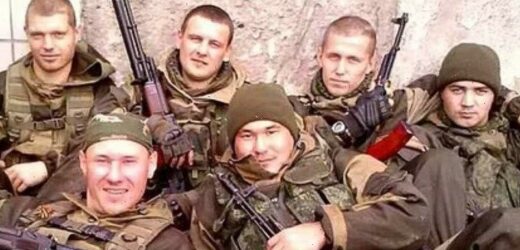Mercenaries working for a Kremlin-linked network of private security contractors have taken up arms in Ukraine on Russia’s behalf, US and British officials say.
The network, known as the Wagner Group, first worked in Ukraine in 2014 during Russia’s annexation of the Crimean Peninsula. Since then, its fighters have turned up on battlefields from Syria to Mali.
In Russia’s invasion of Ukraine, about 1000 Wagner mercenaries are concentrated in the country’s east, where Pentagon officials say Russia has refocused its war effort after failing to capture the capital, Kyiv.
Germany’s foreign intelligence services claimed this week to have intercepted communication that could link Wagner to the indiscriminate killings of Ukrainian civilians.
The Russians viewed the use of the Wagner Group in Syria as a successful part of that campaign.
Russian officials have denied links to the Wagner Group, whose true ownership and funding sources remain unclear. But experts say that it has deep ties to the Kremlin, serving as a tactical tool for Moscow in hot spots where Russia has political and financial interests.
What is the Wagner Group?
It is not a publicly listed private security company but a network of organisations providing fighters for hire.
Experts say that it employs an estimated 5000 fighters. Its ranks were mainly made up of Russians with military experience, said Samuel Ramani, an associate fellow at the Royal United Services Institute, although in recent years, Wagner has also recruited from elsewhere, including Syria.
According to research by the Centre for Strategic and International Studies in Washington, Wagner Group is suspected or proved to have operated in about 30 countries and has two training camps in Russia. It is ostensibly private but, according to CSIS, “its management and operations are deeply intertwined with the Russian military and intelligence community”.
Wagner has been linked by Western intelligence agencies and news reports to Russian oligarch Yevgeniy Prigozhin, an ally of President Vladimir Putin’s who was indicted by US special counsel Robert Mueller for allegedly interfering in the 2016 US presidential election and who analysts say could be a middleman for Kremlin financing of the group.
Also unclear is who leads Wagner. According to US and European officials, Wagner is led by Dmitry Utkin, a former head of Russia’s foreign military intelligence agency.
Washington and Brussels have imposed sanctions on individuals, including Utkin, who they say are affiliated with Wagner. The United Nations has accused the group of committing offences that possibly constitute war crimes.
The firm “has recruited, trained and sent private military operatives to conflict zones around the world to fuel violence, loot natural resources and intimidate civilians in violation of international law, including international human rights law”, according to a European Union statement in December revealing new sanctions against the Wagner Group as part of an effort to deter Putin from invading Ukraine.
One of Wagner’s key functions, according to the Soufan Centre, a nonprofit think tank based in New York City, is that it provides Russia with “a thin veneer of plausible deniability as it engages in the pursuit of finance, influence, and vigilantism not in keeping with international norms”.
What is the Wagner Group doing in Ukraine?
In 2014, the Wagner Group helped train, organise and arm the Russian-backed militias fighting for control of Ukraine’s eastern Donbas region. Wagner operatives also participated in the fighting and in intelligence gathering, according to CSIS, and were reportedly part of Russia’s seizure and illegal annexation of Ukraine’s Crimea region.
Now, US officials say they are back.
In January, amid Russian threats of war, Wagner reportedly began moving some of its operatives from the Central African Republic to eastern Ukraine, said Ramani.
Pentagon press secretary John Kirby told reporters in March that the organisation had about 1000 fighters in the Donbas.
“They have used Wagner contractors in the Donbas over the last eight years,” said Kirby. “So this is an area where the Wagner group is experienced.”
Exactly how many Wagner mercenaries are in Ukraine and where they are coming from remains unknown.
Although there were “indications” that Wagner had been recruiting from places including Libya and Syria, Kirby said he did not know how many such recruits were operating in Ukraine.
The New York Times reported in March that Syrian President Bashar Assad sent hundreds of Syrian fighters to join Russian forces in Ukraine and that Syrian recruiters were drawing up lists of interested potential recruits.
German intelligence officials claim to have intercepted communication between Russian forces that indicate Wagner fighters may have been involved in the indiscriminate killings of civilians in parts of Ukraine occupied by Russian forces.
Where else does the group operate?
In the past eight years, Wagner forces have been reported in Syria, Libya, Sudan, Mali, the Central African Republic, Madagascar, Mozambique and Venezuela, according to CSIS. Often, they are employed as security for Russian assets or the host governments; other times, they have been engaged on battlefields.
Soon after Wagner Group first popped up in Ukraine, mercenaries tied to the group were reported in Syria, where in 2015 Putin intervened on the side of Assad in the country’s civil war. In Syria, the paramilitary group provided security to Russian and Syrian military facilities and participated in some fighting, such as Assad’s campaign to recapture the city of Palmyra.
Wagner forces there also were part of the deadliest U.S.-Russian confrontation since the Cold War in 2018, when U.S. troops and their allies near Syria’s Deir al-Zour responded to an attack by fighters loyal to Assad with a counterattack that killed about 100 people – Russian mercenaries among them.
In oil-rich Libya, Wagner operatives have been fighting on the side of the renegade Libyan commander Khalifa Hifter in his battle to oust the U.N.-backed government, set up in 2015 to end the country’s civil war. As with the Syrian war, the fighting in Libya has become a front for regional proxy battles – and the presence of Wagner fighters has signalled that Russia is seeking a stronger hand in the Middle East and North Africa.
Wagner and Russia also are expanding their political and financial reach in Africa. So far, the paramilitary group has been in 18 African countries, a number comprising more than half of the nations in which it has worked, according to CSIS.
“Wagner comes in, further destabilises the country, ravages the mineral resources and makes as much money as they can before they choose to leave,” U.S. Navy Rear Adm. Milton Sands, the head of Special Operations Command Africa, told The Washington Post in early March. “The country is left poorer, weaker and less secure. Every time.”
In recent months in Mali, whose relations with the West are a low point, Wagner mercenaries have guarded the presidential palace and helped track extremists.
In the Central African Republic, Wagner has been helping to prop up the country’s embattled government – and in exchange, a company linked to Prigozhin has been awarded licenses to mine gold and diamonds.
Because of the organisation’s opacity, Western sanctions against individuals associated with it may have only a minimum impact, Ramani said. Contrary to the intent behind sanctions, Moscow also could grow more reliant on Wagner’s profits as Russia’s assets depreciate, he said.
The New York Times
Get a note directly from our foreign correspondents on what’s making headlines around the world. Sign up for the weekly What in the World newsletter here.
Most Viewed in World
From our partners
Source: Read Full Article



